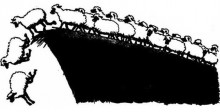Google Penguin Penalty
 Penguin is the name given to Google’s algorithm update which was first released on April 24, 2012. Originally it was simply referred to as a “webspam update”. Off-site webspam like overuse of anchor text in backlinks, and spammy artificial or “unnatural” links were a main target of the Penguin algorithm update. The change, like other algorithm updates, was also designed to filter out websites that violate Google’s Webmaster Guidelines by using other deceptive and manipulative SEO techniques like keyword stuffing, cloaking, link schemes like spam blog networks, deliberate duplicate content, and others.
Penguin is the name given to Google’s algorithm update which was first released on April 24, 2012. Originally it was simply referred to as a “webspam update”. Off-site webspam like overuse of anchor text in backlinks, and spammy artificial or “unnatural” links were a main target of the Penguin algorithm update. The change, like other algorithm updates, was also designed to filter out websites that violate Google’s Webmaster Guidelines by using other deceptive and manipulative SEO techniques like keyword stuffing, cloaking, link schemes like spam blog networks, deliberate duplicate content, and others.
It is important to note the difference between an algorithm update and a penalty. An algorithm update like Penguin or Panda is part of the way Google calculates what is shown in the search results and acts a filter for things that Google does not want to show its users. A penalty is aimed at a specific thing (or things) about a website or its incoming links. This can be especially confusing since it is apparent that the Penguin update does target spammy backlinks, but so does an “unnatural links” penalty, which is manually imposed and comes with a warning from Google’s Webmaster tools. Since most “unnatural” links are likely to use the site’s main target keywords, if you have that penalty, you are likely to also have triggered the Penguin filter.
More about Google Penguin below…





